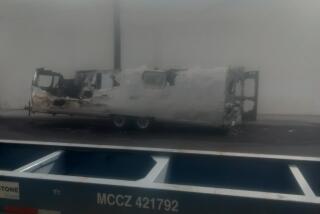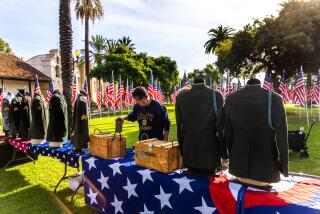Proud Old Bird Is Preened to WWII Fighting Trim in Van Nuys
- Share via
Suspended over Sherman Way, where the street tunnels under the runway at Van Nuys Airport, is the tail of a B-25 that gleams with World War II insignias and pinup art, looking as if it just flew in for a brief furlough from 1944.
For years, it has been seen by thousands of San Fernando Valley commuters every day.
Why?
Because Mike Pupich likes B-25s.
Pupich, 54, of San Fernando, bought the old bomber in 1971 and has lavished work and money on it over the past 14 years, restoring it, flying it in air shows and trying to turn it into an exact copy of the “Heavenly Body,” a B-25 flown in the China-Burma-India theater during the war.
Distinguished Record
“Ever since I was a kid during the war years, I loved those B-25s,” said Pupich, who was 14 when World War II ended. “It’s a classic airplane with a distinguished record. When I got a chance to own one and fly it myself, I couldn’t pass it up.”
Pupich, with the help of friends like Al Rivera, an airline mechanic and Air Force veteran, has tried to restore the plane as close to World War II trim as legally possible, just short of carrying live bombs and remounting the .50-caliber machine guns.
Although the plane has no live weapons, empty practice bombs are mounted in the bomb bay, secured by wires through the release switches to prevent an accidental bomb run on the Valley. A friend who owns another twin-engine B-25 Mitchell medium bomber carried his luggage in the bomb bay when he went on trips, Pupich said, “until one day he accidentally bombed Fresno. Luckily, the suitcases landed in a field someplace and didn’t do any damage.”
Complete With Bombsight
The bombardier’s compartment in the nose cone is equipped with a Norden bombsight. Pupich bought the bombsight, the design of which was one of the most tightly guarded military secrets of the 1930s and early 1940s, from a military scrap dealer.
The plane, for many years a weather-beaten relic, was repainted last fall because Pupich is planning to move it to Eagle Field, an airstrip about 80 miles east of Monterey, that he and some friends are turning into a World War II museum.
“It won’t vanish entirely” from its perch beside Sherman Way, Pupich said. “It’ll be gone for a week or two and then come back for a few weeks.”
Lacks Standard Turret
Built by North American Aviation in a St. Louis plant in 1944, Pupich’s plane never saw combat. It was used as a trainer in the United States and still lacks the standard top machine gunner’s turret, which was left off to make room for two extra seats for students and instructors. It was sold as surplus in 1958 when Air National Guard units phased out obsolete piston-engine bombers, and was flown for about 10 years by a crop-duster in Wyoming, Pupich said.
When a group of about 15 B-25s was assembled for the filming of the World War II black comedy “Catch-22” in 1969, it was one of the relatively few B-25s, out of the 9,815 built, that was still in flying condition. Pupich said he bought it from the aviation company that flew the old planes for the film makers.
The father of a friend was in the 42nd Bomb Group of the 13th Air Force, which served in the China-Burma-India theater in World War II, and had pictures of the group with their B-25s, including the original “Heavenly Body,” Pupich said.
He used that plane as a model for the paint job, with the group’s cross-of-Lorraine “Crusaders” insignia on the tail and a classic 1940s-style pinup girl in a bathing suit painted on the fuselage under the cockpit. Twenty-eight small bombs indicate the 28 missions that plane flew, and two small Japanese flags symbolize two enemy planes shot down. Pupich is about to add a small ship, representing a Japanese freighter the original plane sank, he said.
Pupich does not know what became of the original plane. “I know the crew came back,” he said. “The plane was probably scrapped years ago.”
Old-Timers Pop Up
The plane, so prominently visible to motorists on the busy street next to its parking space, attracts World War II fliers, especially former B-25 pilots, Pupich said.
“At least once or twice a week, some guy whips his car off Sherman Way and comes barreling into the parking lot here just to look at it and ask where I got it.
“Guys pop up who say they flew B-25s and they give me a little more history on the plane. One guy who had been a B-25 instructor opened the trunk of his car and pulled out the original flight manual--a very, very rare book now; I’d never seen one before--and gave it to me. He’d carried it around with him all these years.
“He came back the next day and gave me the flight instructor’s manual and the original radio microphone he had used in his plane.”
No one who flew in the original “Heavenly Body” has appeared yet, he said, but he hopes someone will show up someday.
Expensive Hobby
Flying your own bomber is not a cheap hobby, said Pupich, who owns a company that plates sheet metal for computer manufacturers. When the military dumped the planes on the surplus market in batches in the 1950s, the price dropped to $800 at one point, he said. But by 1971 he paid $4,000 for the plane, “and today they’re worth a quarter of a million, there are so few of them left.”
“I think there’s only about 10 still in flying condition in the United States. I heard some were sold to some South American air forces, and there’s supposed to be a couple in England and one in Australia.”
Maintenance costs him about $35,000 a year, Pupich said. “It takes 40 hours of work on the plane for every hour we spend in the air.”
His crew chief is Rivera, a former Army paratrooper, air commando and Air Force B-25 mechanic. Rivera worked for Pupich as an employee for three years, restoring the plane, then continued as an unpaid helper.
Fun at Air Shows
“It’s a hobby, and it gets in your blood,” Rivera said. “Half the kick is taking the plane to air shows, letting other people enjoy it. There’s a lot of history there, and it’s amazing how many people know and appreciate these planes.”
The plane’s next home will be a former World War II Air Corps training field near Los Banos. Pupich said he and some partners have bought the field and some land around it from the federal government. They are stocking it with World War II memorabilia, including at least two other planes, anti-aircraft guns and a half-track, trying to duplicate the look of an American airfield in the China-Burma-India theater during the war, and hope to open May 25, with admission to be free at first.
“We may want donations or a fee later, when we have more exhibits,” he said.
The B-25’s day in combat was just about over when Pupich went to war himself. Drafted to serve in Korea, he was not yet a pilot--he took up flying in 1963, as a civilian--and he served on the ground as a rifleman.
More to Read
Sign up for Essential California
The most important California stories and recommendations in your inbox every morning.
You may occasionally receive promotional content from the Los Angeles Times.










